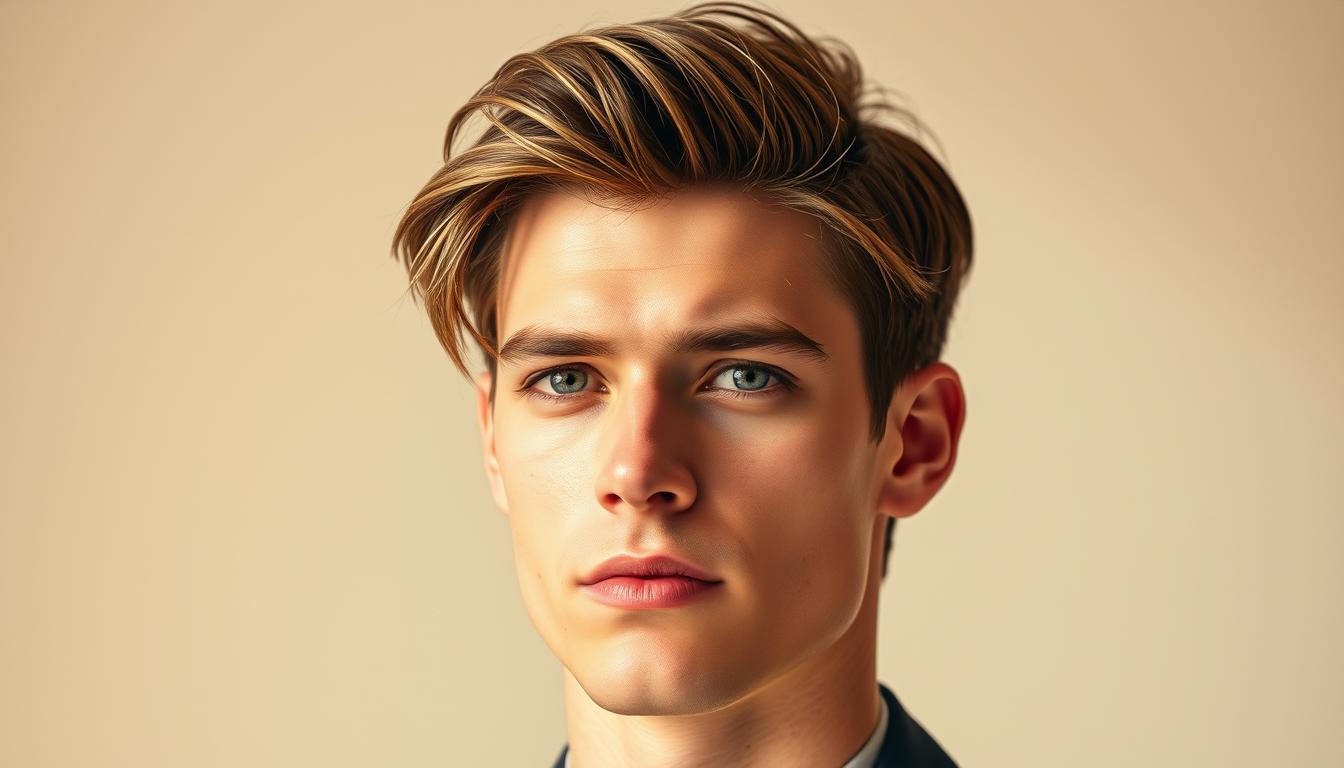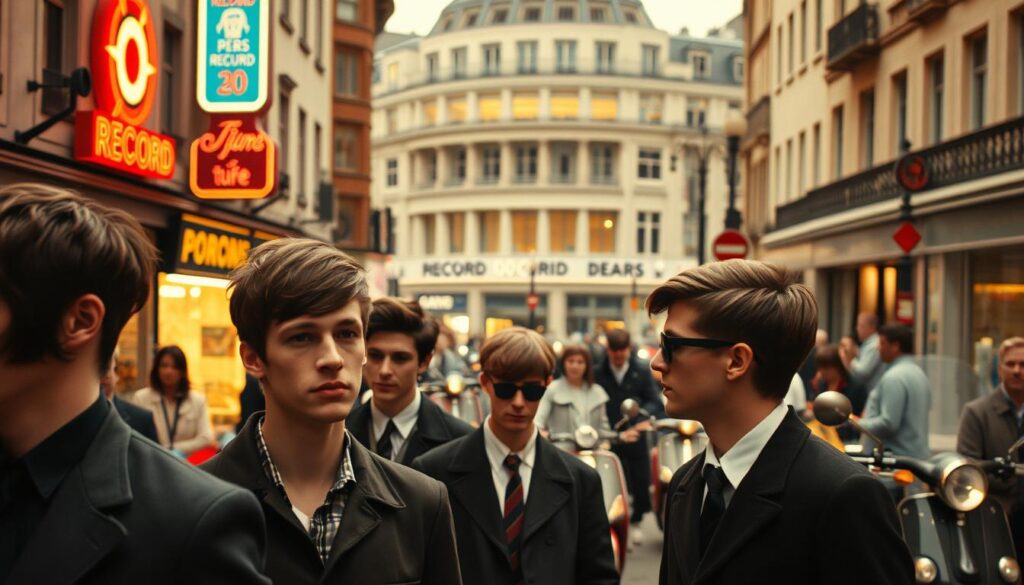
Can a hairstyle simultaneously defy conventions and define modern elegance? The answer lies in a retro-inspired look that’s making waves again—a style born from London’s rebellious 1960s youth culture. Originally sported by musicians and fashion-forward innovators, this cut merges vintage edge with today’s desire for effortless cool.
Characterized by textured layers on top and a bold fringe, this design creates natural volume that works with your hair’s movement. Its secret? A balance of structure and casual flow, perfect for those who want to stand out without looking overly polished. Whether you’re aiming for a messy finish or a cleaner silhouette, it adapts to oval, square, or heart-shaped faces with ease.
But why does this decades-old style resonate now? It’s more than just aesthetics—it’s a statement. Artists, creatives, and anyone craving individuality gravitate toward its mix of rebellion and refinement. The cut’s history ties it to cultural shifts, yet its versatility keeps it fresh for modern wardrobes and personalities.
Key Takeaways
- Blends 1960s rebellious roots with contemporary sophistication
- Features textured layers, thick fringe, and tailored sideburns
- Popular among artists and trendsetters seeking unique expression
- Works for most face shapes, especially oval and square
- Celebrates individuality while maintaining timeless appeal
- Easy to style for both casual and polished looks
Unveiling the Origins and Cultural Impact of the Mod Haircut

What began as a post-war rebellion in 1950s Britain became a blueprint for timeless cool. Young creatives rejected conservative norms, embracing jazz clubs and sharp tailoring. Their distinctive look—clean lines, bold fringes, and volume at the crown—mirrored their desire to stand apart.
The Birth of the Mod Movement in the 50s and 60s
By the mid-1960s, this subculture defined London’s streets. The style fused Italian suits with French New Wave aesthetics, but its hair became the ultimate symbol. Thick sideburns framed faces, while cropped backs contrasted with textured tops. Musicians like Rod Stewart turned it into a badge of identity, blending rock-and-roll energy with polished edges.
How Cultural Shifts Influenced the Cut’s Evolution
Decades later, bands like Oasis revived the look during the Britpop era. Softer layers replaced rigid shapes, adapting to grunge and indie trends. Yet the core remained: a balance of rebellion and sophistication. Each generation reinterpreted it, proving its flexibility across music scenes—from punk to alternative rock.
This evolution reflects broader shifts in self-expression. What started as a youth movement now thrives as a universal statement. Its legacy? A cut that bends but never breaks, always echoing its roots in defiance.
Explore Inspiring Mod Haircut Looks

From sleek retro vibes to bold modern statements, this iconic style offers endless ways to reinvent your look. Discover how designers and celebrities reinterpret its core elements for fresh appeal.
Classic 60s Cut with a Modern Twist
The original design keeps hair shorter at the back and sides, with fuller layers on top. Today’s versions soften the fringe, letting it graze eyebrows instead of sitting blunt. Pair it with tapered sideburns for timeless edge.
Edgy Variations: Rocker and Textured Cuts
Want more attitude? Try chunky spikes at the crown with disconnected sides. Textured cuts use choppy layers to create messy volume. Both styles work with natural waves or straight hair.
Creative Celebrity Inspirations
Jacob Elordi rocks longer lengths with side-swept fringe and defined edges. Paul Mescal opts for tousled layers that frame square jawlines. These stars prove how adaptable the look remains across hair types.
Whether you prefer collar-length backs or shaggy punk-inspired cuts, there’s a version matching your personality. Barber tip: Thicker hair handles spiky textures best, while finer strands shines with blended layers.
Essential Styling Tips and Tools for Your mod haircut
Unlock your style’s full potential with smart product choices and pro-level techniques. The right approach enhances natural texture while creating that effortless volume central to this iconic aesthetic.
Product Power: Build Your Arsenal
Match your hair type to these game-changers:
| Product | Best For | Key Effect |
|---|---|---|
| Styling Clay | Thick hair | Gritty texture + flexible hold |
| Curl Cream | Wavy/curly | Defined movement |
| Sea Salt Spray | Fine strands | Lived-in waves |
| Matte Pomade | Sleek fringe | Controlled finish |
Start with damp hair. Blow-dry upward using a round brush – this lifts roots for maximum volume. For curls, twist sections while drying. Finish with two spritzes of texturizing spray, scrunching ends for movement.
Home Styling vs. Pro Guidance
While DIY methods work for daily upkeep, consult a barber every 6-8 weeks. They’ll refine your soft edges and adjust layers to maintain shape. “Bring photos showing both your ideal look and current style,” advises Manhattan stylist Liam Carter. “This helps us bridge the gap between home maintenance and salon results.”
For quick touch-ups, rub a pea-sized amount of clay between palms. Warm it up, then rake through dry hair focusing on the crown. This revives texture without weighing down your signature silhouette.
Tailor Your mod haircut to Your Unique Hair Type
Your natural texture shouldn’t limit your style choices. This iconic look thrives when customized to your hair type and face shape. Skilled stylists can adjust proportions and techniques to highlight your best features while honoring the cut’s rebellious spirit.
Working With Straight, Wavy, and Curly Textures
Straight hair shines with sharp contrasts. Ask your barber for choppy layers at the crown and a cropped back. This creates architectural definition. Shorter fringe adds edge without overwhelming square jawlines.
Wavy textures enhance movement. Keep fringe longer to blend with natural patterns. Extend sideburn length to balance volume on top. “Waves add built-in texture,” says LA stylist Marco Reyes. “We focus on strategic layering to avoid bulk.”
| Hair Type | Styling Focus | Key Features |
|---|---|---|
| Straight | Precision edges | {{the}} fringe, angular layers |
| Wavy | Natural flow | Longer sideburns, blended texture |
| Curly | Controlled shape | Full fringe, tapered nape |
Curly hair needs adapted techniques. Stylists maintain the signature fringe and sideburns while softening layers. The nape stays tapered to prevent triangular shapes. Use curl cream to define without stiffness.
Face shape matters most for proportions. Oval and square faces handle shorter sides best. Round faces benefit from extended length at the temples. Always discuss your daily routine with your stylist—low-maintenance versions exist for busy lifestyles.
Thin hair? Avoid ultra-cropped styles. Instead, keep moderate length on top with subtle layers. Matte products add grit without exposing scalp. With smart customization, this look becomes universally wearable.
Conclusion
Your hair isn’t just a style—it’s a canvas for cultural legacy and personal flair. This design’s journey—from 1950s rebellion to modern runways—proves timeless looks thrive through reinvention. More than a trend, it channels confidence while honoring musical pioneers and fashion innovators who shaped its DNA.
Success lies in customization. Collaborate with skilled stylists to tailor layers, fringe, and proportions to your face shape and texture. Whether you prefer subtle office-ready versions or bold, textured statements, the cut adapts to reflect your creative spirit.
Armed with styling know-how—from product picks to maintenance routines—you’ll master that effortless edge. The secret? Balancing structure with movement, much like the subcultures that birthed this aesthetic.
As trends come and go, this look endures by evolving without losing its soul. Ready to redefine your silhouette? Bring inspiration photos to your barber and let your hair speak volumes about who you are—and always aspire to be.
